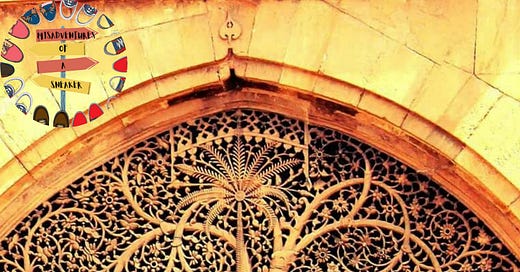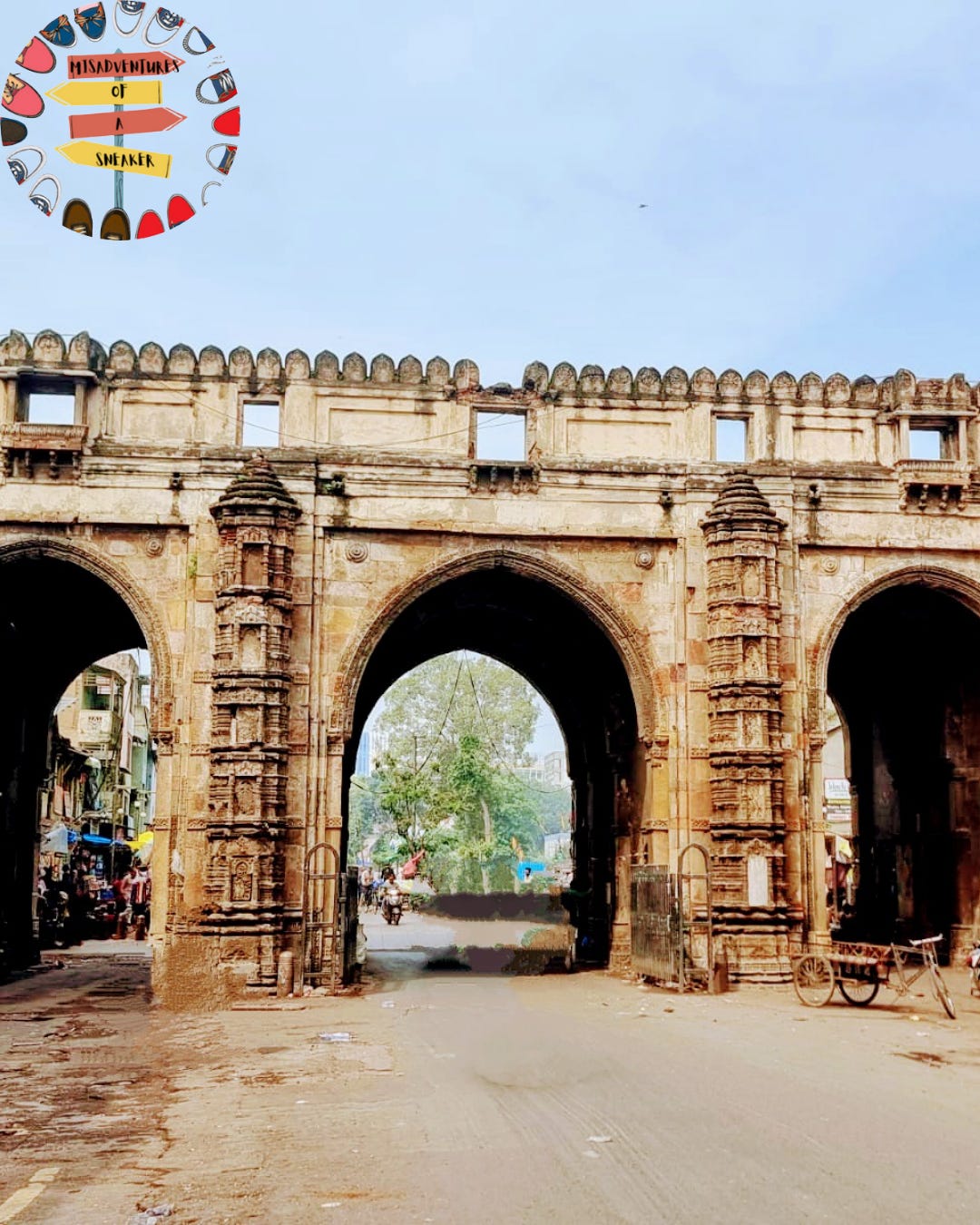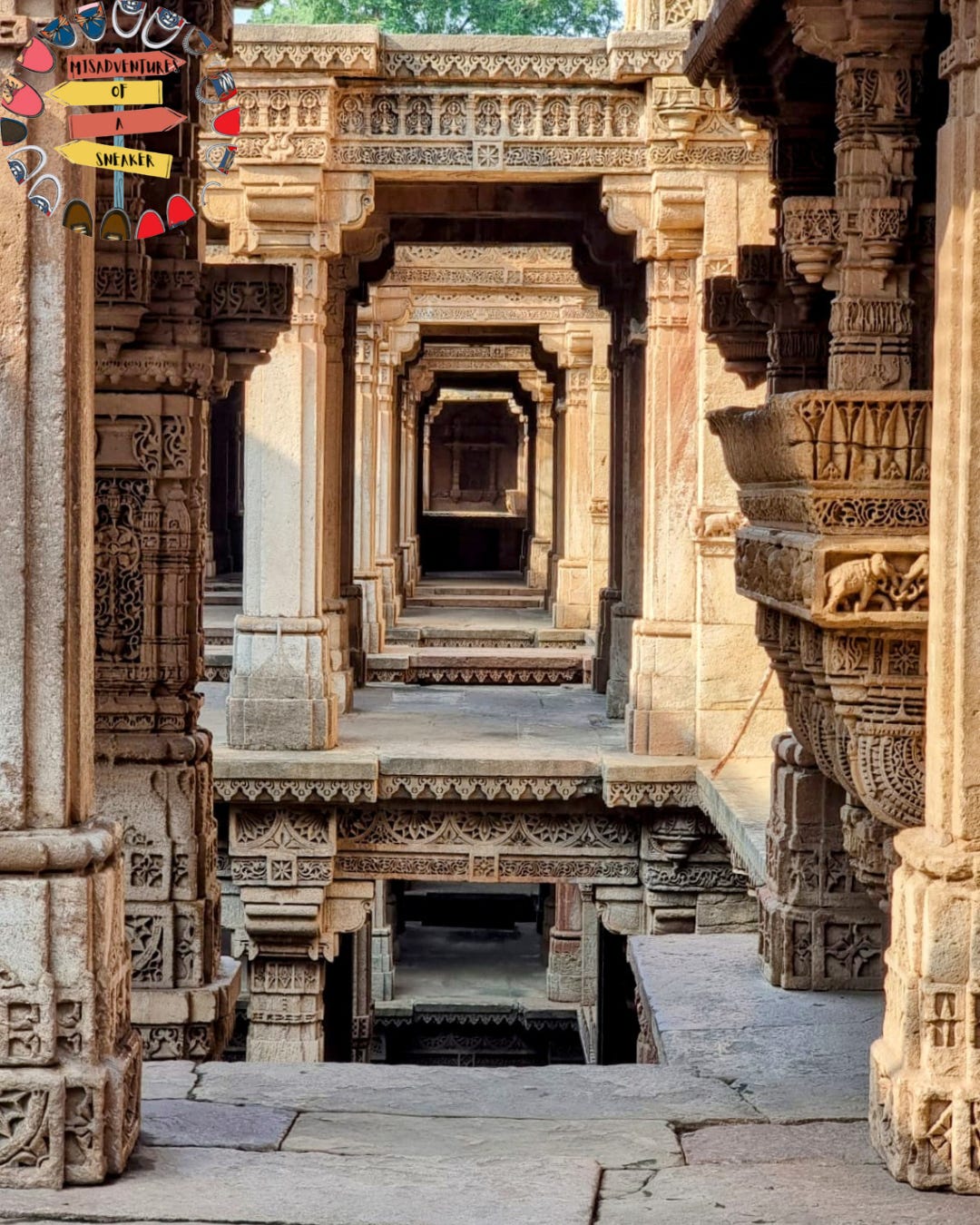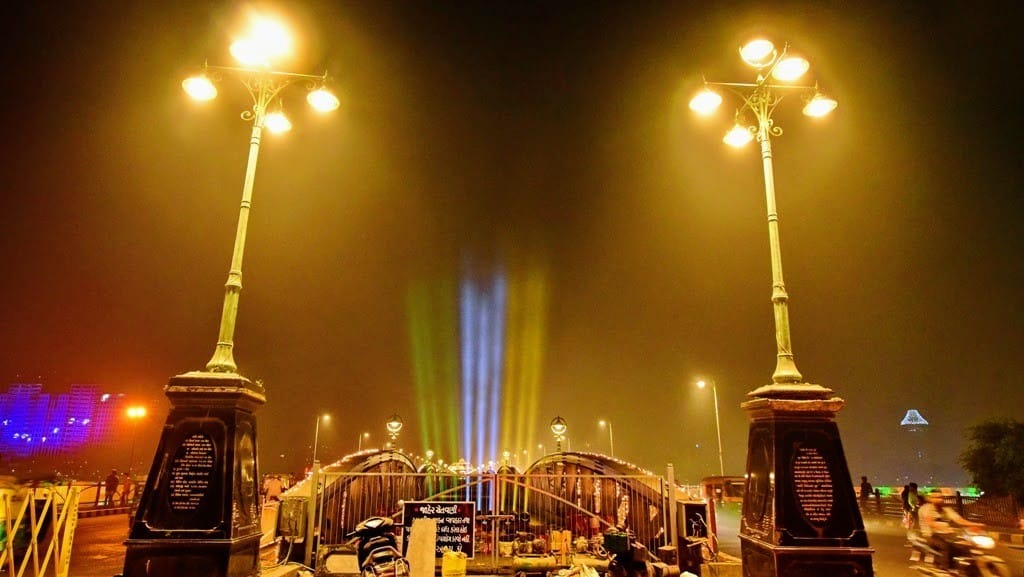Beyond the Walls: Exploring Ahmedabad's Hidden Gems
Echoes of heritage and flavors of Amdavad with Dhwani Parikh
Reflecting on my time in Ahmedabad, I'm instantly transported to the vivacious and energetic vibe of the people, capable of turning any tune into a lively garba beat. They say folks here can dance through the night during Navratri, no matter if they can't run a marathon – talk about boundless energy!
Now, let's dive into the historical vibes and explore the city's heritage sites, winding by-lanes, and all those nooks and crannies. Leading the way is Dhwani, a true-blue Amdavadi. She's the embodiment of sweetness and liveliness. With a perpetual smile adorning her face, she effortlessly brightens up any group with the contagious melody of her laughter. Dhwani is not just a person; she's an Ahmedabad ambassador extraordinaire. She's like a walking, talking guidebook to Ahmedabad with an infectious zest for life!
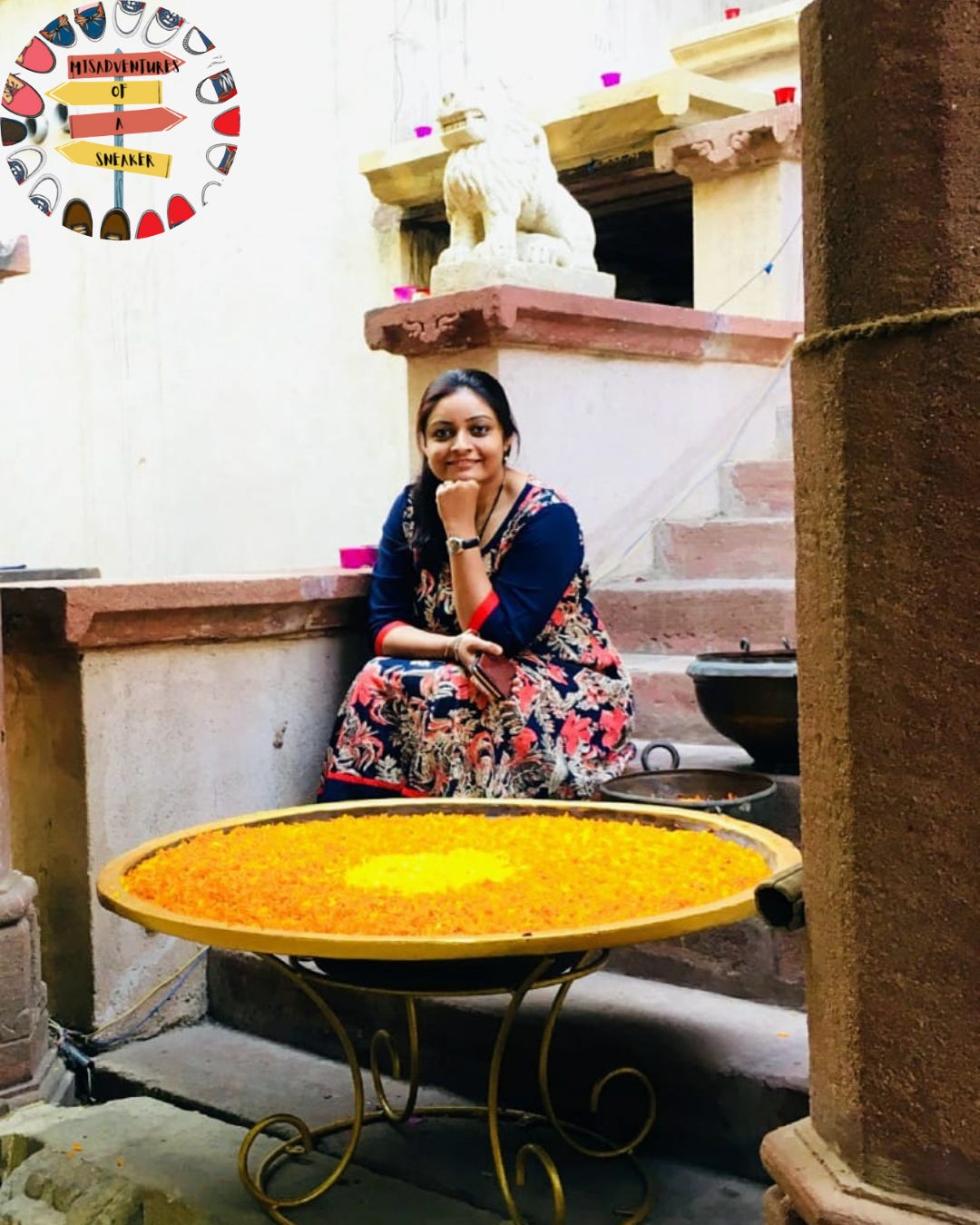
Diving into the recent Navratri festivities, Dhwani unfolds a vibrant tale of the past, reminiscing about the old city Pol area where a 4km-long dance once defined the celebration. Picture this: starting at one point, dancing through intricate steps, and returning to the starting point after a spirited 45-50 minutes! However, the landscape has shifted, and the Pol area garba has dwindled due to the rise of party plot garbas.
In the rhythmic world of garba, each city in Gujarat boasts its distinctive style. Baroda's garba scene, for instance, unfolds in a United Way garba ground, where a staggering 1.5 lakh people sync up to the same steps and style, creating a mesmerizing circular spectacle #UnitedStyleGarba . Surat dances to a different beat, and Ahmedabad, true to its eclectic nature, has its distinct garba style #SuratStyleGarba . In fact Dhwani added that even within Ahmedabad, the colleges, like NID, have been hosting Garba since over 50 years and they have their own style garba #NIDstyleGarba 😄
While many are familiar with the vibrancy of Navratri in Ahmedabad, the kaleidoscope of colors that paints the skies during Uttarayan remains a lesser-known spectacle. Every year on the 14th and 15th of January, the city undergoes a festive transformation with schools and offices closing their doors for this special occasion. Rooftops and terraces become the stage for a kite-flying extravaganza, where the entire city comes alive.
Some go all out, setting up rooftop DJs and arranging meals with friends high above the ground. The enthusiasm reaches such heights that some folks with expansive terraces in the Pol area even rent out their spaces for a whopping 25-30k rupees! As the sun sets, the sky becomes a canvas for the enchanting dance of light lanterns, casting a spell of magic over the city.

I vividly recall spending hours on the terrace with my flatmate, attempting to conquer the skies with our kites. It was only when a helpful neighbor's kid joined the adventure that our kites finally soared!
There’s a popular saying in Ahmedabad that ‘Jab kutte pe sassa aaya, tab badshah ne shehr banaya’. (When a hare chased a dog, the king built a city). Legend has it that in 1411 AD, Sultan Ahmed Shah, after a day of scorching heat and battles, rested by the Sabarmati River near Karnavati. There, he witnessed an extraordinary sight—a rabbit chasing a dog! Amazed by the little animal's courage, the king decided to expand the city on the riverbank, naming it Ahmedabad, the ‘City of Ahmed’.
A century later, Ahmedabad faced threats of war from neighboring kingdoms and the formidable Mughals. In a bid to safeguard his people, the ruler, a descendant of Sultan Ahmed, erected a formidable wall around the city. This fortification boasted 16 gates, serving as vital passages to major roadways connecting Ahmedabad with distant trade hubs. Today, a small section of the wall and 12 gates endures, standing resilient and impressive despite the bustling traffic passing beneath their intricately carved arches and balconies.
Ahmedabad, the heritage city, offers a rich tapestry of attractions conveniently close to each other. Landmarks like Jama Masjid mosque, Bhadra Fort, and Teen Darwaza cluster in the same area, with Sidi Saiyyed Ni Jaali, a historical mosque renowned for its 1573 architecture, just a few steps away. Its stone latticework even inspired the logo of Ahmedabad!
Adjacent to Sidi Saiyyed Ni Jaali lies Lucky Cafe, a unique eatery built around an unexpected cemetery. Lucky's owner, Krishnan Kutti, embraced the challenge and incorporated the burial plots into the restaurant's design, with steel bars protecting the graves. The graves, believed to belong to 16th-century Sufi saint followers, serve as unconventional dinner companions. Far from being morbid, Kutti considers dining in the presence of the dead to bring good luck, a sentiment reflected in the cafe's thriving popularity over a decade. The graves are respectfully tended to daily, with fresh flowers placed nearby. Dhwani highly highly recommends getting Ahmedabad famous maska bun and chai there!
A short distance from the Sidi Saiyyed Ni Jaali, you'll discover the Bhadra Fort, nestled in the heart of a lively market. With its name derived from the Bhadra Kali temple within, this fort is a significant component of Ahmedabad's oldest enclave, established by Sultan Ahmed Shah. Dating back to 1411, it features royal palaces, gardens, mosques, and gates. The fort's clock tower, added by the British East India Company in 1878, adds to its grandeur.
Originally part of Ahmedabad's oldest enclave, founded by Sultan Ahmed Shah, Bhadra Fort has undergone changes over the years. The Azam Khan Sarai, built in the 17th century, and a Maratha-added temple contribute to its diverse history. The British incorporated a section, including the iconic clock tower installed with Ahmedabad's first electric lights in 1915.
One of the popular legends associated with the fort is about Laxmi, the Goddess of Wealth, who was stopped by Siddique Kotwal who asked her not to leave the fort until he had obtained permission from the king. He beheaded himself to keep Laxmi in the city, resulting in the prosperity of Ahmedabad. The tomb of Siddique Kotwal stands near the fort.
Whenever I strolled into Bhadra Fort, the rooftop became a must-visit spot for me, offering a breathtaking panoramic view of the old city. It's fascinating to think that ages ago, the vicinity of Teen Darwaja and the Fort witnessed grand royal processions and spirited polo games. What astonishes me now is the vibrant transformation – the very same area is now a bustling labyrinth of shops.
Just a few steps away from the Bhadra Fort is the Teen Darwaza- a landmark so iconic that it graces the logo of the Ahmedabad Municipal Corporation. Built by Ahmed Shah in 1415, its name originates from the three distinctive arches it proudly boasts.
While here, explore the gate's pillar to discover an inscription from 1812 by Chimnaji Raghunath, a Maratha governor, championing women's equal rights to inherit ancestral property.
And hold up, as mentioned earlier, the area around this spot is a shopping paradise! Junk jewelry, trinkets, and more – the whole place is a shopaholic's dream. Just a heads up, though – flex those bargaining skills because there are tons of shops selling all sorts of knick-knacks. So, after you've geeked out on history at the gate and fort, treat yourself to a bit of retail therapy.
Just a few steps from Teen Darwaja and Bhadra Fort lies the remarkable Jama Masjid. Constructed by Sultan Ahmed Shah in 1424, this colossal mosque was once among India's largest and remains one of the country's most beautiful. Amidst bustling streets, it offers an unexpectedly serene retreat—a quiet corner of remarkable tranquility.
Fashioned in yellow sandstone, the mosque exemplifies Indo-Saracenic architecture with over 260 columns in the main prayer hall, adorned by 15 domes. Interestingly, it's said that the stones used were sourced from dismantled Jain and Hindu temples. The mosque's lighting is gentle, with the perforated stone shielding the interiors from harsh sunlight. Despite losing its minarets to earthquake damage in 1957, the Jama Masjid is a well-preserved testament to historical grandeur.
Rani no Hajiro, the resting place of Sultan Ahmed Shah's queens, lies to the east of Badshah No Hajiro, the sultan’s mausoleum. Constructed in 1445, this complex exudes a delicate and feminine charm distinct from the king's mausoleum. The open courtyard arrangement of the queen’s tombs sets it apart from other tomb complexes in the city, adorned with rich brocade works and intricate carvings blending Jain, Islamic, and Hindu architectural styles.
Dhwani highly recommends exploring the bustling market nearby, where vendors offer clothing, handicrafts, and artificial jewellery. It's one of Ahmedabad's liveliest shopping destinations, featuring traditional Garba dresses, jewellery, accessories, and a treasure trove of other items waiting to be discovered!
Sabarmati Ashram, Mahatma Gandhi's former residence, rests along the serene Sabarmati River, sprawling across 36 acres and widely recognized as the Gandhi Ashram. Serving as the epicenter of India's freedom movement, it witnessed historic events like the Salt Satyagraha and the Dandi March. The Gandhi Smarak Sangrahalaya museum within the ashram showcases artifacts from Gandhi's life, offering glimpses of his writing desk, personal letters, and more.
The ashram is a peaceful spot by the Sabarmati River, perfect for quiet moments. What adds to the charm is the array of activities hosted by various NGOs within the ashram grounds. I thoroughly enjoyed witnessing and sometimes even participating in these engaging initiatives.

While at Sabarmati Ashram, you can also explore the Calico Textile Museum which is pretty close to the Ashram. Founded in 1949, it showcases an exquisite collection of Indian textiles, some dating back over 300 years! The museum showcases a remarkable collection, from Kashmiri shawls to Patolas using double ikat techniques, rare silk-and-cotton mashru weaving, exquisite embroideries, and more.
Dhwani spills the beans about Ahmedabad being India's textile hotspot, calling it our very own Manchester. Her uncle, employed in textile mills, used to bring home matching fabrics, turning the entire family into a squad with twinning outfits. It was a quirky time of rocking those "same same" clothes – talk about family fashion coordination! 🤣
Some of my fondest memories in Ahmedabad involve just chilling by the Sabarmati Riverfront, lost in my thoughts – deep reflections or simply zoning out. Dhwani spills the beans about how the riverfront wasn't always the cool spot it is now. The connection between the old and new city, the whole vibe of the riverfront, it's a recent glow-up! Back in the day, the river was just a sand-mining area for construction. In Gujarati, they playfully called it the 'Donkey's Playground'! Talk about a glow-up journey!
Kankaria Lake, the cool hangout spot in Ahmedabad, has been around since, like, forever – we're talking 15th century vibes! The embankments? Totally rocking some impressive sandstone artistry, and there's this rad island garden called Nagina Wadi – you can even hop on a boat to get there. They even host a mind-blowing light & sound show about Ahmedabad!
So, Dhwani reveals that it was built back in the Gujarat Sultanate days, serving as a crucial water source. Fast forward to 2008, and bam! The Kankaria Lakefront Redevelopment Project turns it into this lively hub with an Atal Express toy train, cool gardens, and a balloon ride. The lakefront is like an adventure playground – boat rides, Segway fun, tree-climbing antics, and mini-golf madness. Then there's Kid’s City, Kamala Nehru Hill Garden Zoological Park, Balvatika, a Natural History Museum, and the Butterfly Park, adding a whole lot of swag.
Oh, and in the morning, don't sleep on the homemade breakfast scene – local people show up with some homemade authentic gujrati dishes that's as yummy as it gets! Come evening, Kankaria Lake turns into the place for laid-back strolls, runs, and just hanging out.
If you're into exploring cool step-wells around Ahmedabad, check out Dada Hari ni Vav or Adalaj Stepwell. While Dada Hari ni Vav is in Ahmedabad, Adalaj Stepwell is 12 kms from the city.
Dada Hari ni Vav, constructed in 1499–1500, is dedicated to Bai Harir Sultana, the harem superintendent of Sultan Mahmud Shah Begada. Its architectural style reflects respect for women and state employees. This stepwell is a standout for its impressive construction, earlier aimed to conserve water in Gujarat.
Now, Adalaj Vav is another vibe. Constructed in 1498 by Queen Rudadevi, it's like a dedication to her husband Rana Veer Singh. This five-story wonder screams Solanki style with its sandstone game, big pillars, and some seriously detailed carvings.
When exploring Ahmedabad's culinary scene, brace yourself for generous helpings of sev and cheese adorning almost every dish! The best part? The flavors are just as delightful. Check out these must-try food suggestions curated by Dhwani.
House of MG - for authentic Gujarati food, very unique dishes which taste just like home.
Chandravilas for Gujrati snacks like fafda, gathiya, bhajiya and their epic Gujarati dal.
While you are in Ahmedabad, definitely try their pani- puri which comes with 5-10 different flavours of the paani!
Charbhuja sandwich near Ashram road (near the Sardar Patel stadium) for some yumilicious sandwiches!
Honest Pav Bhaji (branches all over) & City Pav Bhaji (near MICA) for the best pav bhaajis! But Dhwani’s favourite place is the ‘Mumbai Pav Bhaji’ restaurant located near drive-in theatre → you get 'khada pav bhaji’ here which you must try.
Vada Pav from R.K Vada Pav located near Vijay chaar rasta
Karnavati Dabeli - original one is in Maninagar (near Kankaria lake), but you have other branches too (example: in Judges bungalow road)
Now comes some shopping time 😍 Dhwani, the shopping pro takes us through her favorite places/areas:
Ratanpole shopping - Getting married or want some heavy wear, head here
Rani no Hajiro- The best oxidised jewellery in the world
CG Road - You get branded and local shopping experiences here
Law Garden - for some desi and authentic Chaniya choli and all the chunky jewellery. In fact the dupattas from here are also gorgeous!
Sindhu bhavan road - Almost every niche brand has a store in this upmarket area
Ravivari bazar - Did you know there's a hidden shopping gem that opens its doors only on Sundays? Ravivari, the centuries-old market along the Sabarmati, is a treasure trove featuring clothes, utensils, books, antiques, dumbbells, bikes, and even false hair! Established in the 15th century by Sultan Ahmed Shah, this lively market sprawls across a large area, boasting hundreds of stalls and energetic shopkeepers. Originally a weekly event, it commenced between Teen Darwaza and Bhadra Taar, weathered challenges during the 1941 riots, and has thrived at the Sabarmati riverfront since 1954, making it a historic shopping haven in Ahmedabad.
Ahmedabad's charm lies in its seamless traffic flow and convenient public transport. In my experience, you can reach any corner of the city within 45 minutes with an auto, and the best part is they operate on meters!
If buses are more your style, there are numerous options available from key hubs like Kalupur and Lal Darwaza. Additionally, the BRTS buses function like a road-based metro, complete with designated routes and lanes, providing another efficient travel choice!
One great tip that Dhwani shared was that almost everywhere to everywhere you can reach in 45min - even Gandhinagar, which is a neighbouring city can be reached in 45 min. So ideally staying anywhere is totally OK. But, the best areas Dhwani recommended are:
CG rd. - This is almost the center point for Ahmedabad and is close to old and new city. You will also find lots of good hotels here.
Sindhu Bhavan road or SG highway - If you feel like pampering yourself a little, this area has a lot of luxury hotels.
University area - Also a good location to stay in.
Embarking on this whirlwind adventure through Ahmedabad, we've surfed the waves of vibrant culture, tiptoed through the corridors of history, and skipped along the lanes of delightful attractions—all under the watchful eye of our travel sage, Dhwani. From the awe-inspiring Bhadra Fort to the majestic Jama Masjid, the tranquil Sabarmati Ashram, and the chill-out hotspot, Kankaria Lake, each spot oozes charm like a masala chai on a rainy day. Dhwani's tales of Ahmedabad's makeover and its lively fiestas—think Navratri vibes and Uttarayan kite symphonies—added a dash of personal flair to our escapade.
Dhwani doubles as an ambassador for both Incredible India and Apnu Amdavad, proving she's not just a guide but the 'jaan' of the group. Her love affair with local delicacies, especially the evergreen theplas and khakras, is unmatched—making her the undisputed gourmet guru of our expedition. Here's to Dhwani, the heartbeat of our journey and the spirit animal of every travel squad she graces with her infectious enthusiasm!
Recommended itinerary
Day 1: Old city and Pol area of Ahmedabad
Heritage city walking tour
Early evening go for a long walk around Kankaria lake and experience the light and sound show
Optional: Visit the Calico museum of textiles
Day 2:
Explore Ahmedabad’s shopping scene (areas mentioned in the blog)
Go to Atal bridge again in the morning and see the kite shaped bridge
Visit Gandhi Sabarmati ashram
Sabarmati riverfront in the evening (post sunset) + Atal bridge when lit up
Day 3:
Spend a day at the science city
Explore ISRO
Day 4: Visit Gandhinagar
Enroute stop at Adalaj ni Vav stepwell and spend a few hours
Narendra Modi cricket stadium at Motera
Visit the Akshardham temple in early evening and see the light and sound show post sunset
If you have additional days:
Rani ki Vav + Patan + Modhera sun temple : Can be covered in the same day.
Ambaji temple - day trip.
Statue of Unity + Kabirvad can be covered in 1.5 days.


